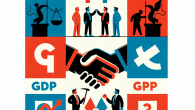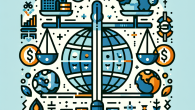
The Federal Reserve’s Dual Mandate: Conflict or Complement?
The Domino Effect: How Emerging Markets Are Responding to the Fed’s Interest Rate Decisions
As a student (and now, rather reluctant professor) of the dismal science known as economics, I have long marveled at how quickly global markets react to even the faintest murmur from the Federal Reserve. The mere suggestion of an interest rate hike in Washington can send currencies tumbling in Jakarta, bond yields climbing in Johannesburg, and ministers pacing in Brasília. Welcome to the domino effect—the Fed sneezes, and emerging markets catch the economic equivalent of a cold.
But why do emerging markets react so intensely to monetary policy decisions made 10,000 miles away? Pull up a leather chair, pour a glass of something aged, and let’s pull apart the gears behind this global financial mechanism.
The Power of the Federal Reserve: More Than Just a Domestic Tool
At its core, the Federal Reserve (or simply “The Fed” to friends and foes alike) sets benchmark interest rates for the United States. Yet, because of the dollar’s dominant role in global trade and finance, any shift in Fed policy has global implications.
When the Fed raises rates, two key dynamics come into play:
- Capital flight: Investors shift assets to the U.S. in search of higher yields.
- Stronger dollar: Higher rates attract foreign capital, increasing demand for the dollar and weakening local currencies globally.
For emerging economies, which often carry large portions of debt denominated in U.S. dollars, this spells trouble. Imagine your monthly debt payment suddenly doubling in your native currency because of a single vote in the FOMC meeting. Not ideal with dinner guests coming over.
Currency Depreciation: When the Local Money Loses Its Mojo
One of the first and most dramatic effects of a Fed rate hike is currency depreciation in emerging markets. If you’re sitting in Jakarta, Nairobi, or Bogotá, and the Fed announces a 25-basis-point increase, brace yourself. Investors often retreat from these higher-risk currencies, funneling capital back into the safer shores of the U.S. bond market.
Case in point: In March 2022, when the Federal Reserve initiated the first of several rate hikes to combat U.S. inflation, the Indian rupee, South African rand, and Turkish lira all tumbled in response. This wasn’t incidental; it was textbook economics with real-world consequences.
The Inflationary Pressure That Follows
As emerging market currencies weaken, imports—especially essential ones like fuel, food, and pharmaceuticals—become more expensive. This leads to a rise in consumer prices. In countries already grappling with inflationary challenges, this import-led inflation is like throwing kerosene on an open flame.
Capital Flight: A Wealth Migration with Political Baggage
Emerging market economies often depend on foreign portfolio investments to fund development, finance businesses, and support their currencies. But when the Fed raises rates, investors rebalance their portfolios, diverting funds away from riskier assets and into U.S. Treasury securities with better returns and virtually zero default risk.
This not only causes stock market losses across emerging economies but also exacerbates deficits in their balance of payments. In other words: your economic house starts to shake just as your neighbor’s economy throws a champagne party.
Case Study: Brazil’s Volatile Love Affair with U.S. Rates
Brazil offers a vivid example. When U.S. interest rates were low in the early 2010s, Brazil enjoyed a flood of foreign capital. The real strengthened, inflation cooled, and growth prospects flourished. But when the Fed signaled tapering in 2013—what became famously known as the “Taper Tantrum”—Brazil’s markets reeled. The real dropped like a stone, and interest rates in Brazil had to climb rapidly to stem capital flight, choking off economic growth.
Debt Pressure: The Noose Tightens
Emerging markets often borrow in U.S. dollars because global lenders prefer the perceived stability of the greenback. But when the dollar strengthens thanks to rising U.S. rates, the debt-servicing burden for these countries increases.
This is not just a fiscal issue—it becomes a political one. Higher interest payments mean less public investment and more austerity. As seen in Sri Lanka and Pakistan, this dynamic can lead to fiscal crises, protests, and a parade of officials shuffling between national parliaments and Washington D.C., hat in hand at IMF headquarters.
How Are Emerging Markets Fighting Back?
Thankfully, not all emerging markets are passive domino pieces. Some have learned from previous cycles and are fighting back. Here’s how:
- Building foreign exchange reserves to defend national currencies and soothe investor nerves.
- Preemptive rate hikes to stay ahead of capital flight.
- Local currency bond markets that reduce over-reliance on foreign debt.
- Improved fiscal discipline (in theory), creating more trust among global investors.
For instance, Indonesia increased interest rates in lockstep with the United States in 2022, attempting to maintain a yield differential and avoid currency volatility. Meanwhile, Mexico took similar steps, balancing inflation concerns with capital flow priorities. Are these responses perfect? Hardly. But they show a maturing strategy among central banks in emerging economies.
What Does This Mean for Investors?
Global markets are interconnected, and Fed policy changes are akin to tectonic movements beneath the surface of emerging markets. For investors, this means a few clear takeaways:
- Risk assessment is dynamic: Don’t assume an emerging market bond with a juicy return is a safe bet during U.S. tightening cycles.
- Currency hedging is crucial: Especially when investing across borders prone to exchange rate shocks.
- Monitor the Fed like a hawk: Rates won’t rise forever, but when they do, capital follows crude logic.
Understanding the ripple effects of U.S. monetary policy isn’t just for macroeconomists with elbow-patch blazers. It’s essential knowledge for anyone hoping to navigate the choppy waters of global finance.
Final Thoughts from Dr. Whitmore: The Game of Synchronization
In my years teaching and consulting (and bemoaning the coffee in countless central bank cafeterias), I’ve observed that economic surprises are rarely the problem. It’s unpreparedness that causes most of the panic.
Emerging markets no longer live in ignorance of the Fed’s might. But the game now is one of synchronization. The question is not, “Will the Fed raise rates again?” but rather, “What do we do before they do?”
As always, knowledge is power. So keep your eye on the dot plot, your ear to Powell’s tone, and your money diversified.
For more insights into macroeconomic trends and global finance, visit our About Us page or reach out directly via our Contact channel.









Leave a Reply